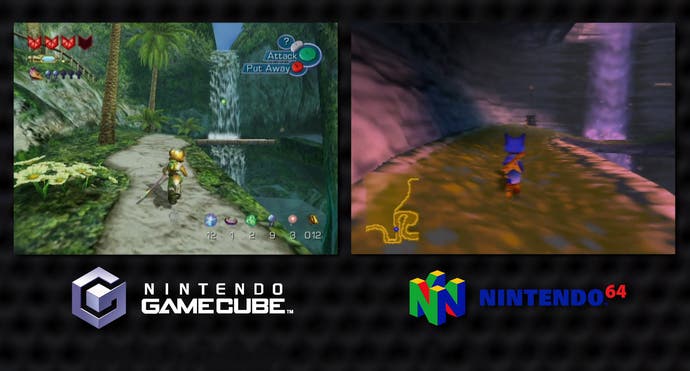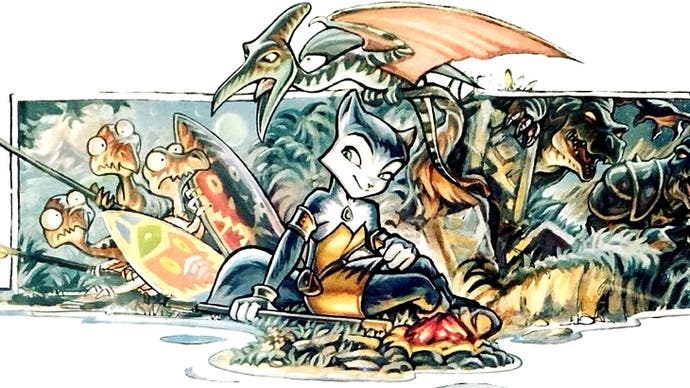Inside Dinosaur Planet - examining Rare's recently recovered 'lost' N64 game
A closer look at the project that would become Star Fox Adventures on GameCube.
Rewind to the turn of the century - the next generation of console gaming was in its infancy with the arrival of Sega Dreamcast and the promise of PlayStation 2, but Rare was busy finishing up its latest Nintendo 64 projects. Perfect Dark was set to arrive that summer after multiple delays, Conker's Bad Fur Day would arrive the following year, but it was Dinosaur Planet that would perhaps be the most exciting title of the lot.
Magazine articles teased a multi-character, Zelda-style action adventure set in a beautiful dino-inhabited world. It was shaping up to become one of the largest games Rare had ever produced but before it reached the finish line, the game was cancelled and development shifted to the Nintendo GameCube, where it became Star Fox Adventures. Dinosaur Planet became a 'lost' game then, never properly seen outside of Nintendo until recently, when a surprisingly complete build salvaged from development hardware appeared.
In the new episode of DF Retro embedded below, I take a look at the recovered code in depth, see how many of its ideas, levels and art transitioned across to Star Fox Adventures and we also talk to one of the people who actually made it. In the process, we'll also re-assess Star Fox Adventures itself - a game that didn't receive the many accolades traditionally bestowed upon Nintendo first party output, but a title that's clearly one of the most technologically advanced games on the platform. Thanks to the arrival of the lost N64 code, we can now more readily appreciate its achievements, along with the level of work required to take the original game concept and move it on to the new hardware.
As for the original game itself, as you'll discover from our interview with ex-Rare (now Playtonic) developer Kev Bayliss, it was initially based around a new character - a tiger. The tiger in question has played a role in Rare's history. First developed for a prior Rare title, he made his debut in Diddy Kong Racing before being planned as the main character for Dinosaur Planet. However, at some point in development, the focus changed to a new adventure featuring a wolf called Sabre (harkening back to Ultimate Play the Game icon Sabrewulf), before Nintendo intervened, suggesting that Fox McCloud from Star Fox may be a better fit. It's interesting to note that the recovered Dinosaur Planet code seems to have come from the transition point: Fox McCloud is a key character, but he's still often referred to in dialogue as Sabre.
What's clear is that Dinosaur Planet is a game that shares much with late-generation Rare N64 titles. It requires the expansion pack, offering exceptionally high-quality visuals for the platform, but runs at a low frame-rate. What really separates this from many other N64 titles, I feel, is the richness of the texture work. Sure, it can't compare to modern games (and even Star Fox Adventures delivers a huge leap) but the amount of detail packed into each area is significant. Banjo Kazooie, released earlier in the system's life, features much simpler repeating texture patterns and less complex scenery but even that was a step above what most other third parties were delivering on the platform. Dinosaur Planet look set to take N64 visuals to the next level.
Beyond this, Dinosaur Planet offers dynamic time of day progression along with dynamic weather. This is combined with surprisingly effective use of the N64's fog capabilities to produce beautifully atmospheric environments. It seems that usage of the N64 expansion pack is reserved for expanding texture quality as the game does not utilise the system's high resolution rendering mode outside of the main menu, which is gorgeous. It looks great then but how much of this world can you visit in this build and how does it compare to the GameCube original?

So, this is where things get complicated. This build has a lot of content packed within the ROM but much of it is inaccessible through normal gameplay. There is an already large community doing a lot of work reverse engineering and picking apart everything they can - new discoveries are being made all the time, in fact - but if you just load up the leaked ROM and start playing, the experience is rather incomplete. In the video you'll see how much of the content looks, and how it compares to the final GameCube title we received - but beyond that, you'll appreciate what an incredible generational leap in power the Cube delivered. Star Fox Adventures has around 4x the resolution running at around 3x to 4x the frame-rate, while the density of the visuals and the effects work in play is on another level. It still looks great today.
The recovered N64 build suggests that Dinosaur Planet would have been one of the largest games produced for the system. It features a massive, interconnected world with excellent textures for the system. The potent combination of dynamic time of day and fogging allows for some beautiful sequences. Clearly, however, this game would never have run especially well - and it has to be said that one of the key aspects that dates a great many N64 titles isn't so much the often blurry artwork, it's the choppy performance. And in that sense, I feel it's a good thing that it was shifted to GameCube. It runs at a high frame-rate, it features many advanced techniques targeting the new hardware (including some impressive animated grass) and the world is packed with detail.

Star Fox Adventures also completely seamless, which is perhaps the most impressive achievement. The GameCube was Nintendo's first console based around an optical disc and there was concern about how this would impact the immediacy of the games, but Rare managed to implement a high-speed data streaming solution that outperformed what N64 was achieving and there is virtually zero loading visible to the user during normal gameplay. Part of this is tied to strategically building transitional areas. For instance, the Thorntail Hollow map seems to act as a hub of sorts. There are multiple areas you can reach from here but each of them is connected by linking maps, which are smaller in scope and detail. It works both in terms of increasing the perception of a larger world and also, perhaps, eases the load on the streaming system.
As impressive as Star Fox Adventures was - and is - it was also the last Rare game to ship on a Nintendo home console, which is a shame. At the time, games such as Kameo and Perfect Dark Zero were in the works for the GameCube, but these would be shifted to not one but two different machines on the road to completion as Rare was acquired by Microsoft and became one of its most prolific internal studios. As for this incomplete build of Dinosaur Planet, it's an interesting piece of gaming history that now has additional context behind it. It's also really just the beginning - it's fascinating to play in its current state but I'm more excited about how it could change in the future as the retro development community digs deep into the game. Dinosaur Planet will never be the game that Rare originally intended it to be, but the retro community may yet deliver a version of the title that's playable from start to finish...










